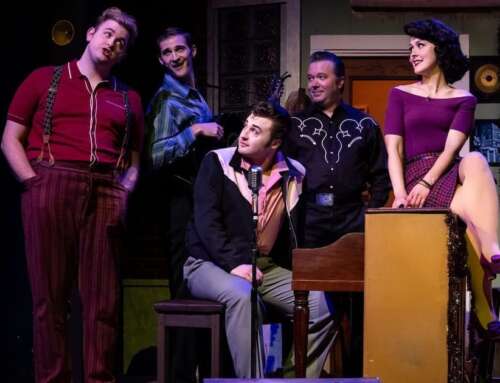Impressive performances and top-notch tech from Lake Dillon Theatre Company can’t save Lauren Gunderson’s weak script
The revolution is coming! What do they want? Unfortunately, The Revolutionists can never quite answer that question. While Lake Dillon Theatre Company’s production features strong acting, a lovely set, and solid staging, they couldn’t save the play’s weak script.
The Revolutionists (subtitled “A Comedy, a Quartet, a Revolutionary Dream Fugue, a True Story”), written by Lauren Gunderson, follows four women during the French Revolution’s Reign of Terror, who are all executed. The play imagines what would have happened if playwright Olympe de Gouges, assassin Charlotte Corday, former queen Marie Antoinette, and Haitian rebel Marianne Angelle hung out and gossiped before their deaths.
Things don’t look good for these women. For all the rebels’ talk of rebellion, they strongly dislike other people rebelling against them as these women have done. Along the way, the four women share stories, discuss their legacies and make a lot of jokes about whether or not this play should be a musical (ala the much better piece of theatre: Les Misérables).
Gunderson has carved out a niche for herself within the playwrighting world through recontextualizing old stories for a new audience. She’s written Miss Bennett, The Book of Will, Exit Pursued by a Bear, Earthrise, Silent Sky, Toil & Trouble, and Peter and Wendy. Some of these plays are quite well written and interestingly developed; this is not one of them. The Revolutionists premiered at Cincinnati Playhouse in the Park in February 2016 and desperately reeks of being Gunderson’s attempt to cash in on the Hamilton craze.
Gunderson takes a bunch of obscure historical figures that no one has heard of and pairs them with broad references to a social issue; boom, it’s sure to be a hit! Right? Unfortunately, it’s a little more complicated than that. Gunderson confusingly blends real biographies with imagined ones and doesn’t provide a ton of context for what is going on (I overheard two attendees grumbling that they were confused by the play’s historical content and didn’t understand what was going on as they left during intermission and did not return). The historical inconsistencies and some elements of Gunderson’s reimagination have been questioned by critics who point out that, notably, the play’s sole black character is an amalgamation of several people rather than a fully-fledged historical woman with a lived biography.
Gunderson defends this on the play’s Tumblr – yes, she is still using Tumblr in 2022 – by arguing it’s because Olmype, the writer and show’s lead, wouldn’t have known any black people and so she just made up this character. Gunderson explains that it is a meta-theatrical play and what we are watching “is a fiction made up by Olympe in her final moments alive before the guillotine. In those moments she creates relationships to comfort, interrogate, and inspire her. ”
This is not a satisfying response (a white woman making up a black woman to complement her writing and tell her she’s doing good?) and only further reveals the play’s biggest issue: It’s not a revolutionary tale about creating a more equitable future for us all but a bohemian tragedy about a self-aggrandizing writer. Gunderson puts four characters together who all come from different backgrounds with vastly contradictory economic interests. Yet, instead of debating these differing political and cultural interests, the characters spend the whole time talking about Olympe, her amazing writing skills, and the play she is writing.
A good production nonetheless
Despite the weak material, the team at Lake Dillon does its best. This was my first time seeing a production in Lake Dillon’s smaller space, The Henry Studio Theatre. It’s an intimate, two-sided black-box theatre that doesn’t have a bad seat. Scenic designer Leah Mazur does a great job decorating the theatre with highly traditional materials: flowing white sheets for walls, Greek columns, and so much marble stain – but they’ve all been destroyed! The columns are broken in half and the marble-stained set pieces have been graffitied; it is really a striking set.
Director Melissa Livingston’s use of levels in her staging and coordination of the technical elements during key scenes in Act 2 were highlights of the piece, and she does as much as she can to help communicate this confusing story to the audience. She directs a skilled ensemble who excel at the show’s dramatic material. Claire Kennedy delivers a knock-out performance as the vain Marie Antoinette. Kennedy has great line delivery throughout and plays Antoinette as a character whose head is far up in the clouds from a life of privilege. She perfectly satirizes the pomp and circumstance the rebels were attempting to oust while making the most of the script’s tired jokes.
Kenya Hamilton nails the difficult emotional beats that Marianne Angelle undergoes. Hamilton’s performance when she receives news about her husband in Act 2 is raw and tear-jerking. Her subsequent exchange with Kennedy about continuing on is played to heartbreaking perfection. Alexis DeJoy’s energy is fantastic, and she delivers a dynamic performance as the spunky Charlotte Corday. DeJoy never rushes through her lines and grounds Corday’s manic, violent energy in a place of truth and desperation. Bille Aken-Tyers’ portrayal of Olympe de Gouges was the least effective of the ensemble, and she really struggled with the character’s comedy. I don’t know how much of this is the fault of the actor though; as discussed earlier, her character (the writer) is the weakest written. Aken-Tyers handles the narration the character is given well and does a great job during the character’s dramatic exchanges with Hamilton in Act 2 and in her final scene.
The direction of the accents was a little all over the place. Despite the French setting, Aken-Tyers does a strong British accent, Kennedy slips in and out of a light, posh British accent, and Hamilton and DeJoy perform with American accents. It’s not a huge deal, but the inconsistency was a little distracting. Livingston chose to incorporate projections into the production – something I am not always a fan of – but I thought it was minimally and effectively utilized. I quite liked the isolated use of projections for comedic bits (my favorite being a Clue projection parody performed by Hamilton in Act 1) and to show the audience real-world depictions of these women.
Costume designer Rachel-Anne Germinario takes full advantage of the historical setting. Marie Antoinette’s costume is a standout. Germinario designs Kennedy in a lovely blue dress that blends multiple fabrics, laces, and ribbons together, and styles the look with a fabulous feather wig, cheeky blue-pink glasses, and cute heels

Costume designer Rachel-Anne Germinario has a lot of fun with Claire Kennedy’s Marie Antoinette look. | Photo: Nat Boggs/Lake Dillon Theatre Co.
with pink bows. Olympe de Gouges’s green dress is a little ill-fitting but styled well and paired with an excellent shade of green nail polish. Charlotte Corday’s dress is fittingly simple and paired with a lovely pair of heels. Marianne Angelle is outfitted in a well-designed yellow ensemble decked out with red jewels.
The lighting and sound design by Martha Carter and Aerik Harbet are so good that I almost wish they had integrated more of these technical elements throughout the production. The play’s long dialogue scenes are performed mostly free of tech. Yet, Livingston’s choice to isolate these technical elements to a few key scenes – like the execution and opening/endings of Acts 1 and 2 – help these moments stand out.
Great theatre asks challenging questions for the audience to chew on; good theater offers the audience entertainment and a fun time out; boring theatre comforts the audience through broad, self-satisfying generalizations. Despite the best efforts of the cast and crew, this isn’t a revolutionary play about feminism. It’s a play about playwriting and not a very interesting one at that. I’d only recommend seeing this production if you are really interested in French history and want to be exposed to a contemporary playwright — or if you want to support the hard (and incredible technically impressive) work by the Lake Dillon Theatre Company’s actors and designers.
A Colorado-based arts reporter originally from Mineola, Texas, who writes about the changing world of theater and culture, with a focus on the financial realities of art production, emerging forms and arts leadership. He’s the Managing Editor of Bucket List Community Cafe, a contributor to Denver Westword and Estes Valley Voice, resident storyteller for the Bonfils-Stanton Foundation and co-host of the OnStage Colorado Podcast. He holds an MBA and an MA in Theatre & Performance Studies from CU Boulder, and his reporting and reviews combine business and artistic expertise.





Leave A Comment